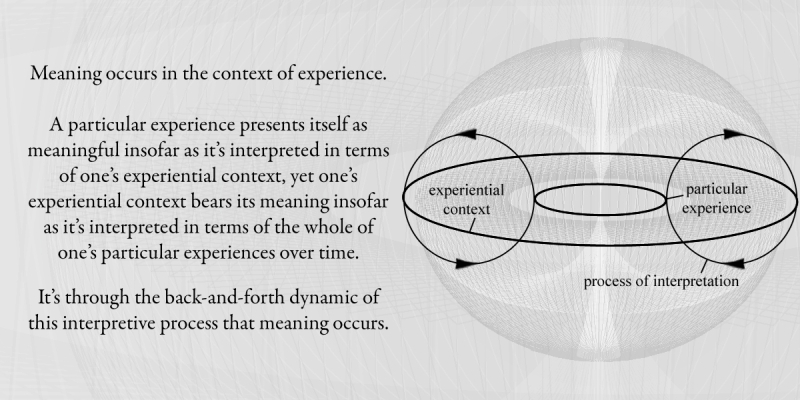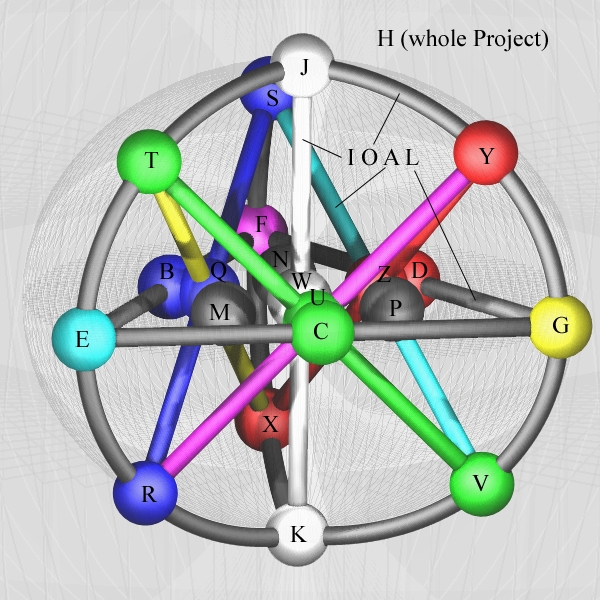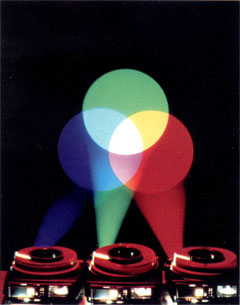




































representational inquiry regarding meaning
Please see the intro. slides for an overview of how this Project addresses the question of meaning (at least with respect to meaning's structure).
The Project's core structure involves 26 questions. These questions are informed by the underlying logic from which they emerged. Since the questions may be restated—i.e., since the terms in which the Project's main divisions/questions are understood might be reconceived depending on the context—it is desirable to identify some abstract way to refer to these 26 constitutive elements separate from any specific content they express. To this end, each of the 26 is assigned one letter of the Latin alphabet.
Yet letters themselves are not purely abstract; they already bear some meaning given their histories, their shapes, the words in which they commonly appear, and so on. So, the assignment of letters in this Project is not purely arbitrary. Moreover, the tenuous meanings each letter individually bears can't be forcibly wiped clean by their linear assignation to the Project since the Project itself is not linear in nature; any linear assignation of letters to a non-linear system would create the false illusion of linearity. The assignment of letters to this Project's questions must therefore be an act of creative appropriation given a mixture of the following considerations:
Here's a chart showing the approximate origins of the current Latin alphabet with suggested numerical values (and subsequent order changes) for Latin letters given the alphabet's history:
The changes to the current Latin sequence that need to be justified are: 1) the order reversal of I and J, 2) the insertion of W between N and O, and 3) the alignment of proposed numerical values with modern Hebrew rather than the more closely related (evolutionarily speaking) modern Greek—hence the gap between P and Q. I'll take them each in turn.
1) The order reversal of I and J. First, J is a newcomer to the alphabet; it emerged from I. The deep history of J just is the history of I. Therefore, the order they appear with respect to each other is of secondary importance to I's original placement in the alphabet order with respect to the other letters. In the first abjads/alphabets, the letter teth (Hebrew tet and Greek theta) appeared between the H- and I-equivalents in those systems. Since this letter teth/tet/theta has no Latin equivalent, there's a gap in the order there. So, it makes sense to fill that gap with the Latin J to preserve the original order.
2) The insertion of W between N and O. Once again, in the original abjad/alphabet sequence, there was a letter samekh that appeared between the N-equivalent (nun) and the O-equivalent (ayin). Since there is no Latin equivalent of samekh, a gap is opened between N and O. Moreover, our letters after the letter T didn't appear in the first alphabets, so we have surplus letters, one of which can be used to fill this gap. And why is it desirable to fill the gap and not simply shift the letters down, closing it? It's because of the numerical associations with the letters—just like J and I: I is the original letter from which J recently emerged. I's numercial value has always been 10. In the current order of the Latin alphabet, since I comes before J in order, I would be 9 while J would be 10. But, again, since J emerged from I, it seems more fitting that it shouldn't bump I from its traditional position in the sequence. And so there's a similar case with the gap between N and O. The numerical value of N has traditionally been 50, while the numberical value of O has been 70. Samekh was 60, and since there's no Latin equivalent to 60, it's good to find one. W is a good candidate, given its affinity with vav/F/6 (see more at W4.)
3) The alignment of proposed numercial values with Hebrew rather than the more closely related Greek. Beginning at Q, the modern Hebrew and Greek numerical equivalents differ. In Hebrew the Q-equivalent (kuf) is 100, while in Greek the Q-equivalent (koppa) is 90. (See Greek isopsephy vs. Hebrew gematria.) Again, in the original alphabets, there was an additional letter between P and Q. That letter is retained in the Hebrew as tsade, having the numerical value of 90, but there is no modern Greek equivalent. Rather than leave a gap in their numbering, the Greeks shifted their letter values at Q. So, I align the numeric values with the Hebrew over the Greek for two reasons: a) it more closely maps onto the order of the original abjads/alphabets, and b) the numerical values of letters is more important in the Hebraic tradition (with Kabbalah's gematria) than the Greek one.
Given these considerations, the following proposed letter associations are advanced. The justifications for these particular assignments can be found on their respective tab 4 pages.

_selected resources
• History of the alphabet (Wikipedia)
• Albright, W. F. (1969) The Proto-Sinaitic inscriptions and their decipherment [Harvard UP]
• Goldwasser, O. (2006) Canaanites reading hieroglyphs [Ägypten und Levante 16, 121-160]
• Hamilton, G. J. (2006) The origins of the Western Semitic alphabet in Egyptian scripts [Catholic Biblical Association] (partial page proofs here)

The main reasons the letter H is used to designate the Project as a whole are the sound the letter makes and its original meaning.
For English speakers, the letter H makes the subtlest of sounds—merely the passage of breath through the mouth—and so it seems appropriate to use it to indicate the subtlest of questions.
Also, it is thought that the letter originally meant fence or boundary. In this sense, the letter might be thought to indicate an horizon—even the broadest most horizon in which all that is can be meaningfully said to be—namely, the horizon of being itself.
Beyond the primary reasons for assigning the letter H to indicate the Project as a whole are a couple of creative coincidentals of note. H is the first letter of the English word horizon, but also home. Also, the numerical value of the letter H from history is 8, and the Arabic numeral 8 resembles the infinity sign. The Project's horizon demarks the Project's limits (as addressing the question of meaning), but this limit—this horizon—is itself a finite infinity. The "bounded infinity" can be seen in the image of the Project's tree structure as shown on the Welcome page.
Shapes are used diagrammatically and symbolically and can take on different meanings when colored. Below are what the shapes signify without color.
| symbol | description | referent |
 |
center-line axis | experiencer-experiencing-experienced |
 |
cone pointing down/ opening up | experiencer, being-thrown-under |
 |
torus | experiencing, being-thrown-back-and-forth (dialogue, reciprocity, hermeneutic circle) |
 |
cone pointing up/ opening down | experienced, being-thrown-before (in front of, in the way of) |
 |
egg from arcs of unfolding tree | openness to/ horizon of intelligibility |
 |
vesica from intersecting spheres | discursive disclosing of intelligibility |
 |
cone pointing right/ opening left | subjective |
 |
cone pointing left/ opening right | objective |
 |
sphere; cone opening away (centered) | experiencing, attending; active |
 |
l'arbre de rien (tree) | actual (self/world) engagement; meaning-making |
 |
disk/horizontal plane (edge view) | concrete conditions (all) |
 |
disk in network (top view) | particular concrete conditions |
The colors used by this Project are the colors of light, having additive color properties such that white light contains the spectrum.
 |
colors | primary referents | select additional associations | Maslow's needs | |
| white | (all) | unhidden, revealed, disclosed | |||
| magenta | self+world | psychological+physiological | non-duality, flow, transition between levels; skill | transcendence | |
| blue | self | psychological | liberty, self-control, authenticity, will, character; focus | self-actualization | |
| cyan | dynamic+self | sociological+psychological | recognition, empathy; acquaintance | esteem | |
| green | dynamic | sociological | community, reciprocity, sharing, making common; rhythm | love/belonging | |
| yellow | world+dynamic | physiological+sociological | security, stability, reliability; assertion | safety/security | |
| red | world | physiological | materiality, physicality; holism | physiological | |
| black | (none) | hidden, concealed, closed off | |||
